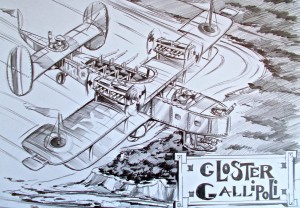
Gloster Gallipolli Mk 1 flies over Portsea during ANZAC Day celebrations. April 25th 1935. This particular aircraft was retired from surface after the beach incident and recurrence of trench feet and lice amongst the platoon manning the central fuselage defensive position. Note distinctive marker flags and push-pull propellors.
The Gloster Gallipoli became legendary as a glorious failure. Incorporating many of the tactical lessons learnt during the Gallipoli campaign it began its career with great promise, but proving the maxim, “all new wars are begun upon assumptions made in the last’. (for example see Paul Mason).
The Gallipoli for all its promise, was outclassed by emerging technologies and the development of radio communication. As a response to the Fashoda Incident, and the recent incursions into Abyssinia and Ethiopia by Italian troops in the mid thirties the Air Ministry outlined a brief for a fast, transport and bomber aircraft, capable of delivering at short notice a platoon to infiltrate enemy defences and assist amphibious landings at dawn. The Gallipoli was developed by the Gloster company from its Townsville office which operated briefly to develop tropicalised versions of the Gladiator and Gauntlet fighters, then under evaluation by the RAAF. Earmarked as the ‘Gallipoli’, it incorporated several of the important lessons learnt from the Dardanelles. The first Gallipoli prototype was an outstanding success during initial airworthy tests, being able to arrive within pinpoint accuracy at the wrong beach. As an austerity measure the powerplant consisted of two coupled morris eight engines, with upgraded carburetion, and higher octane fuel. A two blade macpherson prop gave it a distinctive warbling sound. When unsynchronised the twin flatheads referred to as the flapper or ‘Louise Brooks’. Other refinements in the design are noteworthy. The standard fuselage was a Vickers Vimy bomber modified to incorporate a platoon of troops or marines. From experience gained in the Gallipoli campaign the basic armament was augmented by a “trench” along the main fuselage, and adaptation of Lee Enfield’s in periscope mounts. Beam and aft protection was provided by two “catapult operators’, incorporating a spigot, and spring mortar. Within each mortar a specially adapted exploding jam tin, refined and developed by IXL provided both anti aircraft and field support upon landing. The Gallipoli was the first to incorporate both forward puller, and rear facing pusher airscrews to facilitate attack or retreat.
The pilots forward compartment was augmented with sandbags and bully beef tins designed as a decoy to be tossed at hungry Turks. Under the forward part of the fuselage a “dustbin” type retractable defensive post of twin lewis guns provided excellent protection for enemy aircraft, (Note entrenching tool).
Upon landing the under gun operator, (a Cornish miner) was encouraged to jump and start digging a tunnel towards the enemy lines. Once under the enemy trenches a charge was ignited, a breach made, and the platoon would leave their trench positions for an attack. A problem encountered during trials was the tendency for the Cornish miner to waste considerable time in the tunneling and mining operation to the extent that it as sometimes upwards of three weeks before the platoon could safely disembark. The subsequent scurvy and malnutrition derived from prolonged inactivity, trench feet and bully beef diet rendered the strategy impractical.
Although highly promising in its role as a troop transport and night bomber, the type was passed over by the air force establishment due to the unfortunate habit of losing direction and immolation of the entire crew due to the marker flags which were often mistaken for enemy positions. In one such unlucky encounter a squadron of Gallipoli’s upon landing were blown to pieces by a howitzer battery who mistook the flags for Turks, though the incident , (feb 23rd 1935 black Wednesday about 3.00 pm) took place twenty years after the Gallipoli campaign and on Australian soil. The subsequent enquiry excused the commanding officer of the artillery for his excessive zeal, as the court martial revealed the pilot had inadvertently jettisoned the dustbin machine gun position as it was a Tuesday evening, in his own words ‘when the bins go out”. His acquittal attributed to force of habit. No Gallipoli’s survive, yet it is rumoured that one was used recently discovered off the coast at Geelong, where it was recently re-commissioned as special transport by the Social Services Minister Bronwyn Bishop.
Illustration Gloster Gallipoli over Portsea, sept 1935.
Powerplant; Two Bristol Pegasus inline engines.
Armament: Two type 33 spigot IXL jam tin mortars
12 .303 Lee Enfield Periscope Guns
1x Vickers Gun twin mount in dustbin
Range: 500 miles Ceiling: 12,000 feet
Operators: RAAF, RNZAF Years Active: 1935-36
